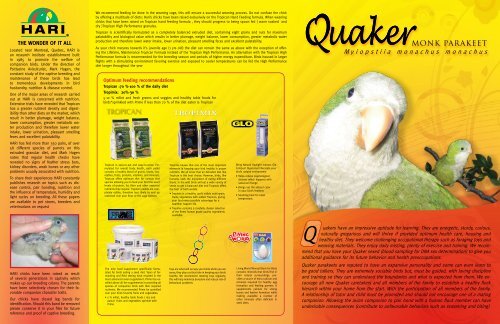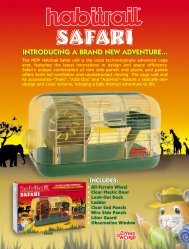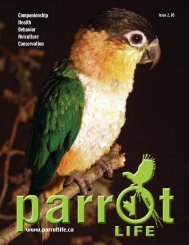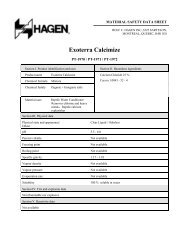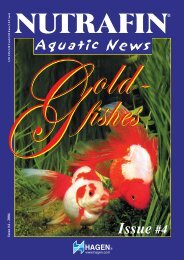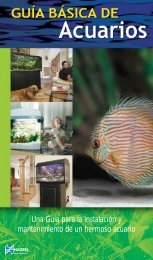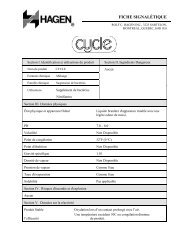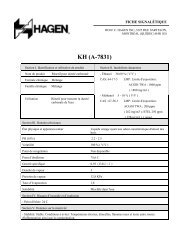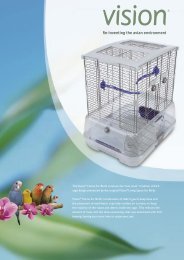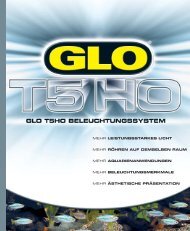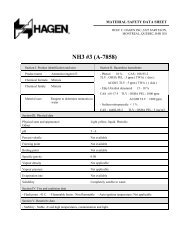You also want an ePaper? Increase the reach of your titles
YUMPU automatically turns print PDFs into web optimized ePapers that Google loves.
THE WONDER OF IT ALL<br />
Located near Montreal, Quebec, HARI is<br />
an research institute establishment built<br />
in 1985 to promote the welfare of<br />
companion birds. Under the direction of<br />
Psittacine Aviculturist, Mark Hagen, the<br />
constant study of the captive breeding and<br />
maintenance of these birds has lead<br />
to tremendous developments in bird<br />
husbandry, nutrition & disease control.<br />
One of the major areas of research carried<br />
out at HARI is concerned with nutrition.<br />
Extensive trials have revealed that Tropican<br />
has a greater nutrient density and digestibility<br />
than other diets on the market, which<br />
result in better plumage, weight balance,<br />
lower consumption, greater metabolic water<br />
production and therefore lower water<br />
intake, lower urination, pleasant smelling<br />
feces and excellent palatability.<br />
HARI has fed more than 350 pairs, of over<br />
58 different species of parrots on this<br />
extruded granular diet, and Mark Hagen<br />
notes that regular health checks have<br />
revealed no signs of feather stress bars,<br />
kidney disorders, weak bones or any other<br />
problems usually associated with nutrition.<br />
To share their experiences HARI constantly<br />
publishes research on topics such as disease<br />
control, pair bonding, nutrition and<br />
the influence of temperature, humidity and<br />
light cycles on breeding. All these papers<br />
are available to pet stores, breeders and<br />
veterinarians on request<br />
HARI chicks have been raised as result<br />
of several generations in captivity which<br />
makes up our breeding colony. The parents<br />
have been selectively chosen for their favorable<br />
companion character traits.<br />
Our chicks have closed leg bands for<br />
identification. Should this band be removed<br />
please conserve it in your files for future<br />
reference and proof of captive breeding.<br />
We recommend feeding be done in the weaning cage, this will ensure a successful weaning process. Do not confuse the chick<br />
by offering a multitude of diets: Hari’s chicks have been raised exclusively on the Tropican Hand Feeding formula. When weaning<br />
chicks that have been raised on Tropican hand feeding formula , they should progress to being spoon fed ( warm soaked and<br />
dry )Tropican High Performance granules.<br />
Tropican is scientifically formulated as a completely balanced extruded diet, containing eight grains and nuts for maximum<br />
palatability and biological value which results in better plumage, weight balance, lower consumption, greater metabolic water<br />
production and therefore lower water intake, lower urination, pleasant smelling feces and excellent palatability.<br />
As your chick matures towards it’s juvenile age (1 yrs old) the diet can remain the same as above with the exception of offering<br />
the Lifetime, Maintenance Tropican Formula instead of the Tropican High Performance. An alternation with the Tropican High<br />
Performance formula is recommended for the breeding season and periods of higher energy expenditure. Birds housed in larger<br />
flights with a stimulating environment favoring exercise and exposed to cooler temperatures can be fed the High Performance<br />
diet longer throughout the year<br />
Optimum feeding recommendations<br />
Tropican :70 %-100 % of the daily diet<br />
Tropimix: 20%-30 %<br />
5-10 % millet and fresh greens and veggies and healthy table foods for<br />
birds*sprinkled with Prime if less than 70 % of the diet eaten is Tropican<br />
Tropican is easy-to-eat and easy-to-serve. Formulated<br />
for overall body health, each pellet<br />
contains a healthy blend of grains, seeds, vegetables,<br />
fruits, proteins, vitamins, and minerals.<br />
Tropican offers optimum diet for various bird<br />
species allowing you to feed your bird the exact<br />
levels of protein, fat, fiber and other essential<br />
nutrients they require. Tropican pellets are completely<br />
edible, therefore less likely to end up<br />
scattered over your floor or the cage bottom.<br />
The only food supplement specifically formulated<br />
for birds eating a seed diet. Years of formulating<br />
and field testing have resulted in the<br />
most advanced avian supplement. Prime has excelled<br />
above all the supplements in providing all<br />
species of companion birds with their required<br />
nutrients. We recommended Prime be sprinkled<br />
over your birds favorite fruits and vegetables.<br />
• 5 % millet, healthy table foods ( rice and<br />
pasta) fruits and vegetables sprinkle with<br />
Prime<br />
Tropimix knows that one of the most important<br />
elements in keeping your bird healthy is proper<br />
nutrition. We all know that an Extruded diet like<br />
Tropican is the best choice. However, birds, like<br />
humans, seek the enjoyment of eating different<br />
foods. In the wild birds will eat a wide variety of<br />
seeds to get a balanced diet and Tropimix offers<br />
the best of both worlds.<br />
• Tropimix is a healthy 100% edible multi-grain,<br />
fruits, vegetables with added Tropican, giving<br />
your bird every possible advantage for a<br />
healthier happier life.<br />
• Tropimix contains a carefully chosen selection<br />
of the finest human grade quality ingredients<br />
available.<br />
Toys are what will occupy your birds while you are<br />
away; they play a critical role in keeping your birds<br />
healthy. We recommend rotating toys regularly,<br />
this will help minimize boredom and reduce risk of<br />
behavioral problems<br />
Bring Natural Daylight Indoors Glo<br />
Compact Fluorescent Recreate your<br />
bird’s natural environment<br />
• Helps relieve psychological<br />
distress which happens with<br />
seasonal change<br />
• Brings out the vibrant color<br />
in your bird’s feathers<br />
• Soothing heat for ideal<br />
temperature.<br />
Living World Mineral Block for Birds<br />
contains minerals that birds find in<br />
their natural surroundings, provides<br />
a source of extra calcium and<br />
minerals required for healthy egg<br />
formation and feeding parents. It<br />
supplements calcium for strong<br />
bones and feather formation while<br />
making available a number of<br />
other minerals often deficient in<br />
seed diets.<br />
Monk Parakeet<br />
Myiopstiia monachus monachus<br />
Q<br />
uakers have an impressive aptitude for learning. They are energetic, sturdy, curious,<br />
naturally gregarious and will thrive if provided optimum health care, housing and<br />
healthy diet. They welcome challenging occupational therapy such as foraging toys and<br />
weaving materials. They enjoy daily misting, plenty of exercise and training. We recommend<br />
that you have your Quaker sexed (blood sampling for DNA sex determination) to give you<br />
additional guidance for its future behavior and health preoccupations.<br />
Quaker parakeets are reputed to have an expansive personality and some can even learn to<br />
be good talkers. They are extremely sociable birds but, must be guided, with loving discipline<br />
and training so they can understand the boundaries and what is expected from them. We encourage<br />
all new Quaker caretakers and all members of the family to establish a healthy flock<br />
hierarch within your home from the start. With the participation of all members of the family.<br />
A relationship of tutor and child must be promoted and should not encourage one of a mating<br />
companion. Allowing the avian companion to pair bond with a human flock member can have<br />
undesirable consequences (contribute to unfavorable behaviors such as screaming and biting)
HUSBANDRY<br />
Information<br />
Congratulations for adopting your new feathered companion.<br />
Here are a few basic recommendations we’ve compiled to<br />
initially guide you to become the best caregiver possible for this<br />
small parrot.<br />
We encourage you to continue your<br />
education with numerous resources<br />
available to provide optimum care,<br />
health and enjoyment for years to come<br />
Name: Date:<br />
Species: (Latin name):<br />
Band #: Opened Closed Physical characteristic for ID:<br />
Microchip #: Chip manufacturer:<br />
Captive bred Breeder: Neonate diet fed:<br />
Age: Hatch date: Unknown Average weight: g<br />
Sex: M F Unknown Sexing method: Sexual dimorphism DNA Surgical sexing<br />
History (source, previous owners, quarantine, parent ID…)<br />
Examination<br />
My Parrot Profile<br />
Polyoma Virus Pacheco’s Virus Psittacose Chlamydia PBFD<br />
Samples taken from: Feathers Blood Nail Vein Droppings Environmental swab<br />
Samples submitted by: To which Lab:<br />
Vaccination (register all records on next page and conserve all documents): Polyoma<br />
Diet provided -specify as much detail as possible (quantity eaten, brands, frequency offered)<br />
Pacheco’s<br />
• Formulated diet: / %<br />
• Grain: / %<br />
• Fruits/veggies: / %<br />
• Supplements (Vitamin’s/Calcium) / %<br />
• Other : / %<br />
Water source & quality: Daily intake: ml<br />
Does your parrot have a cage mate Y N if yes, since when Date:<br />
Are they reproductively active Y N<br />
Are there other birds in your household Y<br />
Species:<br />
N if yes, specify Number:<br />
Primary cage dimensions: length: width: height: Cage manufacturer:<br />
Other cage or activity center / Playgym:<br />
Types of perches: Plastic Wood Concrete Natural branches<br />
Natural branches (specify type of wood):<br />
Pesticide free: Y Unknown Are the perches of varied dimensions: Y N<br />
Exposure to natural sunlight: Y N Full spectrum lighting: Y N<br />
The number of hours of undisturbed sleep per night: Number of hours of daytime nap:<br />
Is the cage covered for the night: Y N Do you retreat your bird to a sleeping cage at night: Y N<br />
Does your parrot get showered mist bathe None Frequency:<br />
Access outside of cage unsupervised: Y N<br />
Do you use hazardous detergents/appliances/ products in your home: Y N<br />
Potentially toxic plant species in your home: Y N Unknown<br />
Is your family or parrot sitters familiar with potentially toxic & hazardous materials: Y N<br />
This profile form can help you, help your bird, by providing valuable information to your veterinarian, bird<br />
sitter or future adoption family. Should your pet require hospitalization or boarding, a copy of your birds profile will be<br />
useful to the clinic or bird sitters. The answers to these questions could be valuable when consulting for medical and<br />
behavioural concerns. The complex nature of these birds should not be limited to these questions. We encourage<br />
you to add as much information as possible to your parrot’s profile form. Conserve this information along with the<br />
birth certificate, feathers, photos, vaccination certificate and health related document.<br />
Medical History<br />
Check the following if your parrot has previously encountered & required medical attention for:<br />
Respiratory problems Intoxication<br />
Allergic reactions Feather plucking<br />
Cloacal papillomas Skin disorder<br />
Egg binding or related peritonitis Ear infection<br />
Fractures Eye infection<br />
Bumble foot/toe amputation Fungal infection<br />
Parasitic infection Trauma<br />
Bacterial infections Other:<br />
Which avian veterinarian clinic have you consulted:<br />
Tel.#( ) Yearly visits: Y N Frequency:<br />
Behavior & Character Traits<br />
Biting: Y N Frequency: Rarely Occasionally Frequently<br />
With whom & under what circumstance:<br />
Screaming: degree and frequency:<br />
Talking abilities: Y N Number of words: Vocabulary:<br />
Language(s) understood:<br />
Grooming and weight monitoring should be<br />
Toilette trained: Y N Specify where:<br />
used as an opportunity to develop trust and<br />
mutual respect with your avian companion.<br />
Do you bring your bird outdoors? Y N<br />
Do you use a harness? Y N Does your bird have an outdoor flight cage? Y N<br />
Are flight feathers trimmed : Y N Frequency and degree:<br />
Does it perform tricks Y<br />
Behavior around children:<br />
N Explain:<br />
Feeding<br />
Suggested readings:<br />
The Guide To Owning a Quaker Parrot,<br />
T.F.H Publications,Inc, author Gayle Soucek<br />
Guide to the Quaker Parrot<br />
(Second Edition) by Mattie Sue Athan<br />
Your chicks’ feeding status:<br />
Chick is presently fed times per day: Morning Noon Evening Late night<br />
Syringe feeding: # ml-cc per feeding using Tropican Hand Feeding Formula<br />
Morning Noon Evening Late night<br />
Spoon feeding: # tsp per feeding using Tropican High Performance Granules<br />
Morning Noon Evening Late night<br />
Weight monitoring is recommended<br />
Chick is partially weaned. Only requires occasional supplemental feeding<br />
to ensure weight is maintained.<br />
at least twice per year to evaluate the<br />
dietary needs and prevent obesity.<br />
Chick is completely weaned but daily monitoring is essential to ensure<br />
there is no regression during the transition to the new environment.<br />
Monitor the weight of the chick on a daily basis if possible especially after its arrival. The purchase of a small scale<br />
is the best investment for monitoring the health of your companion you will ever make.<br />
• The last weight recorded at the breeder’s: g. the of the year 2008.<br />
• The last weight recorded at the point of purchase is: g the date:<br />
“Versatile living quarters”<br />
for your Quaker Parakeet<br />
In order to prevent cage bonding and territorialism,<br />
your bird should be provided with a variety<br />
of habitats. This also helps challenge them<br />
mentally, prompting and encouraging their instincts<br />
for adaptability and independence. Unfortunately<br />
many birds are not provided with<br />
versatile living quarters.<br />
The day cage is perhaps the<br />
most important investment<br />
you can make. It should<br />
be a spacious, stimulating<br />
environment allowing<br />
for plenty of light and air.<br />
Ideally the space within the<br />
day cage should be at least<br />
10 times the size of your<br />
bird with it’s wings opened<br />
or as large as you can accommodate<br />
within your living space. An exercise<br />
gym and a separate training stand are also<br />
recommended.<br />
Your bird should also be provided with a sleeping<br />
cage, covered at night and placed in a quiet<br />
retreat within your home<br />
to allow 10-12 hours of<br />
undisrupted sleep for your<br />
feathered companion. A<br />
“starter” cage, purchased<br />
for weaning and fledgling<br />
chicks, can always be<br />
converted to the sleep (or<br />
boarding cage) once is<br />
not longer needed for its<br />
original purpose.<br />
It is recommended that 12-15 hours of undisrupted<br />
sleep is required by your pet to maintain<br />
a healthy lifestyle. You’d be surprised at<br />
how quickly undesirable behaviours can be<br />
managed and eventually modified when your<br />
pet is provided with a comfortable and secure<br />
night-time retreat. To promote an undisturbed<br />
sleep, the sleeping cage should be covered at<br />
night and located in a quiet and safe location,<br />
away from disturbances and predators (cat or<br />
dog companion animal).<br />
It’s also important to socialize your Quaker<br />
Parakeet. A well-socialized parakeet is curious<br />
and gregarious, takes an interest in its<br />
surroundings and thrives on attention. To<br />
help socialize your pet, you<br />
might want to consider taking<br />
it along to family events<br />
or for strolls through your<br />
neighbourhood. This can<br />
be achieved through the use<br />
of an avian harness such as<br />
the “Aviator”. We strongly<br />
recommend that you begin<br />
acclimatizing your bird to<br />
an avian harness at a young<br />
age (X-small for quakers).<br />
Another method of transporting<br />
your parakeet is by<br />
the use of an avian transport<br />
carrier. From its first<br />
car ride to it’s new home,<br />
to annual vet check-up, to<br />
grooming appointments,<br />
to “play dates” with other<br />
feathered friends – a carrier<br />
plays an essential role.


